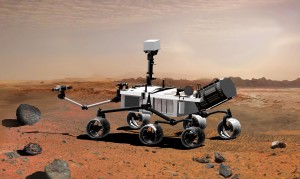 An astronaut is injured in a dust storm on Mars. His crewmates give him up for dead and head home. Miraculously, he survives (some extreme hand-waving is needed to explain that). He makes it to the inflated canvas habitat left behind and must figure out how to survive for 4 years until the next Mars mission arrives. He’ll need food, water, shelter and air. Can he do it? Of course he can; that’s the whole point of the book. There is never any question that he will survive, so the only dramatic tension is from the question, how will he do it?
An astronaut is injured in a dust storm on Mars. His crewmates give him up for dead and head home. Miraculously, he survives (some extreme hand-waving is needed to explain that). He makes it to the inflated canvas habitat left behind and must figure out how to survive for 4 years until the next Mars mission arrives. He’ll need food, water, shelter and air. Can he do it? Of course he can; that’s the whole point of the book. There is never any question that he will survive, so the only dramatic tension is from the question, how will he do it?
He uses plenty of ingenuity to craft solutions to his various problems. As Robinson Crusoe had lots of gear from the shipwreck, the Martian has plenty of equipment and supplies left behind by the 5 crewmates. He just needs to attach this hose to that valve, and so on, which he does, in extreme and repetitious detail.
Are there problems and crises? Of course. He’s got two (count ‘em!) Mars rovers left behind and while they don’t exactly get a flat tire, you know from the very start there will be equipment failure. His crewmates left because of a Martian sandstorm. Do you think there will be another sandstorm? Take a guess. The canvas habitat is inflated. Could it possibly leak? What are the odds? Mars is very cold. Can he find a reliable source of heat? I’ll bet he can. The expected is fulfilled, and the unexpected is entirely expected. Will he get sick, burned, cut, or break his leg? Not a chance.
The character is a smart-talking, joke-cracking, quasi-military NASA engineer with all the personality, reflectiveness, and subtlety you would expect of such a character. The story is told mostly through his daily journal entries, which puts the reader at considerable distance from the action and emotion of the events and contributes to the overall sense of flatness. A tiny bit more interest is generated when the story cuts to scenes at mission control on earth, though not much, since those people are the identical character type.
Oddly, his greatest motivation is a longing to communicate with other people, (which he eventually does accomplish). That need is his only sincere motivational driver. He is quite cavalier about his need to survive. But we don’t know why he has this need to communicate. He is not a reflective person, is emotionally inexpressive, with no strong memories of relationships he longs for, and anyway he seems to have nothing to say except to describe the machinery. There is no explanation of his need to communicate because the character has no interiority, no psychology, no subjectivity. He is a hollow shell of a man.
The story is entirely external and object-oriented. It is not a human story. There is no character development, and the plot is a foregone conclusion. What does that leave? Kind of a technical manual: How to Fix Your Mars Rover. For those who enjoy reading technical manuals, this novel can be recommended.
Weir, Andy. (2011, 2014). The Martian. New York: Random/Crowne/Broadway. (435 pp).
